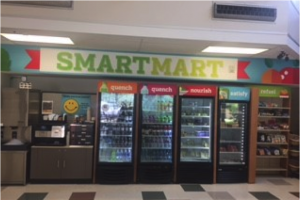By Dorothea Vafiadis and Meg Denning, American Heart Association and Holly McPeak, ODPHP
Today’s consumers recognize healthy eating as an important lifestyle behavior. In fact, 75 percent of consumers know it’s important to lead a healthy, balanced lifestyle and over three-fourths recognize that consuming healthy, nutritious foods are important factors in maintaining that lifestyle. At the American Heart Association (AHA) we are making healthy changes a priority in our workplace, where many adults spend much of their day. AHA’s path to 100% healthy has helped cultivate social norms and encourage employees’ healthy habits, while exceeding financial expectations.

Where to Start?
Despite aspiring to become healthier, the public is confused about how to put their desires into action. It isn’t always easy to eat healthy given the current food and beverage landscape with an array of high-calorie, indulgent foods and drinks available. Through changing food and beverage policies at the organizational level, we are making the healthy choice easier for our employees while taking part in something much bigger – we are driving a change in demand with our food service providers and helping to improve access to healthy options for everyone.
Transitioning to a healthier environment can be challenging, especially without a road map. That’s why AHA developed a science-based resource called the Healthy Workplace Food and Beverage Toolkit to help organizations increase healthy offerings. This resource is used by AHA affiliates across the country and has been introduced in private businesses of all sizes. In step with the government’s Food Service Guidelines, the AHA toolkit addresses almost all aspects of food and beverage eating in the workplace, including vending, catered meals, meetings, and snacks. Today, nearly 7,750 workplaces nationwide are using this resource and working towards a healthy food environment transformation.
One employer in the Southeastern region with more than 500 employees says this resource is making a paradigm shift for the entire office. “Now healthy eating is more of our culture. I see more accountability and thought when employees make food choices,” the happy manager reported.
Taking It On
In 2014, AHA recognized our unique positioning to leverage the toolkit by designing a 100% healthy micromarket, called Smart Mart, at our national headquarters in Dallas, serving 500 employees. With a former part-time cafeteria service that frequently fell short on healthy offerings and a vending mix that had many high-calorie, salty and sugary options, there was room for improvement. The process, though fruitful, had its challenges.
Step 1. AHA completed a catering and vending environmental assessment with a cost analysis and an employee survey to ensure the micromarket would be accepted. Because taste, price, and convenience play an important role in consumers’ receptivity, AHA engaged an internal task force, an external consultant, and the facilities management and human resources departments to lay the foundation for the micromarket. After analyzing the survey results, socializing the concept, researching vendor options, and documenting the environmental landscape, all levels of AHA quickly recognized that implementing the new catering and vending approach would be welcomed.
Step 2. Working with their local food service vendor representatives to design and implement the 100% healthy eating micromarket, the AHA team was invited to the local warehouse to review vending inventory product lists and sample healthier products. The AHA staff dedicated time and resources to identifying and selecting the right mix of healthier snacks, meals and beverages. Emphasis was placed on incorporating fruits, vegetables, whole grains, fat-free/low-fat dairy, nuts/seeds and legumes, while limiting calories, sodium, saturated fats, and added sugars.
“The inventory was vast with over 500 SKUs [Stock Keeping Units] for snacks alone,” said Antigoni Pappas, RDN, senior nutrition manager for AHA. “We were pleased to discover that we could fill the market with tasty products that aligned with our nutrition guidance,” she said.
Step 3. The launch date was set, and today the organization is proud to have the healthiest micromarket in their food service vendor’s business portfolio.
No More Junk Food Temptations
Smart Mart, AHA’s innovative and customized micromarket, has been well-received by employees. According to the one-year follow up survey, 85 percent of employees like that the Smart Mart offers healthy options and 40 percent are more aware of the nutritional content of their food and beverage choices since it opened.
Not only are AHA employees enjoying the Smart Mart, but financial expectations have also been exceeded and paying off! In early 2016, AHA nearly hit its three-month sales goal within one month.
The micromarket success is best summed up by survey feedback from AHA employees:
“(I’m) so happy that AHA has worked to bring healthy options into our workplace, making it easy to make smarter choices.”
“It’s a great option when you’re in a bind and need “real” food.”
“I love the selection and I appreciate that everything is healthier than I would typically pick up!”
The senior management team is enthusiastic that AHA continues offering a variety of packaged and refrigerated foods and beverages, and delights at seeing employees select nutritious and delicious choices for meals and snacks.
Meanwhile, the team continues working towards continuous improvement through engaging employees for feedback and is working to enhance the Smart Mart’s healthy food and beverage offerings over time.
AHA is committed to helping Americans achieve better cardiovascular health. Role modelling good behavior is an important part of that commitment. Our case study shows that a 100% healthy micromarket is doable and can inspire employees to eat better and lead healthier lifestyles. Ultimately it’s about making the healthy choice the easy choice.
More Information for Federal Facilities
The CDC has developed resources for implementing food service guidelines to provide healthier food and beverage options in federal facilities. In addition, ChangeLab Solutions has developed an Exceed tool which explains how to include food service guidelines in contracts, as well as provides a resource library that includes case studies.